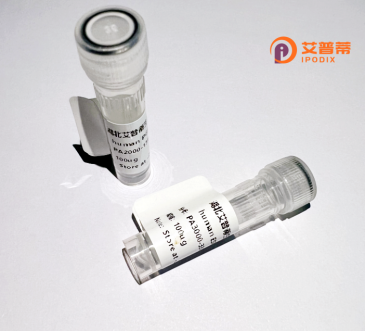
| 纯度 | >90%SDS-PAGE. |
| 种属 | Human |
| 靶点 | RABGAP1 |
| Uniprot No | Q9Y3P9 |
| 内毒素 | < 0.01EU/μg |
| 表达宿主 | E.coli |
| 表达区间 | 1-997 aa |
| 活性数据 | MDDQPGEKELVKRSQLDGEGDGPLSNQLSASSTINPVPLVGLQKPEMSLPVKPGQGDSEASSPFTPVADEDSVVFSKLTYLGCASVNAPRSEVEALRMMSILRSQCQISLDVTLSVPNVSEGIVRLLDPQTNTEIANYPIYKILFCVRGHDGTPESDCFAFTESHYNAELFRIHVFRCEIQEAVSRILYSFATAFRRSAKQTPLSATAAPQTPDSDIFTFSVSLEIKEDDGKGYFSAVPKDKDRQCFKLRQGIDKKIVIYVQQTTNKELAIERCFGLLLSPGKDVRNSDMHLLDLESMGKSSDGKSYVITGSWNPKSPHFQVVNEETPKDKVLFMTTAVDLVITEVQEPVRFLLETKVRVCSPNERLFWPFSKRSTTENFFLKLKQIKQRERKNNTDTLYEVVCLESESERERRKTTASPSVRLPQSGSQSSVIPSPPEDDEEEDNDEPLLSGSGDVSKECAEKILETWGELLSKWHLNLNVRPKQLSSLVRNGVPEALRGEVWQLLAGCHNNDHLVEKYRILITKESPQDSAITRDINRTFPAHDYFKDTGGDGQDSLYKICKAYSVYDEEIGYCQGQSFLAAVLLLHMPEEQAFSVLVKIMFDYGLRELFKQNFEDLHCKFYQLERLMQEYIPDLYNHFLDISLEAHMYASQWFLTLFTAKFPLYMVFHIIDLLLCEGISVIFNVALGLLKTSKDDLLLTDFEGALKFFRVQLPKRYRSEENAKKLMELACNMKISQKKLKKYEKEYHTMREQQAQQEDPIERFERENRRLQEANMRLEQENDDLAHELVTSKIALRKDLDNAEEKADALNKELLMTKQKLIDAEEEKRRLEEESAQLKEMCRRELDKAESEIKKNSSIIGDYKQICSQLSERLEKQQTANKVEIEKIRQKVDDCERCREFFNKEGRVKGISSTKEVLDEDTDEEKETLKNQLREMELELAQTKLQLVEAECKIQDLEHHLGLALNEVQAAKKTWFNRTLSSIKTATGVQGKETC |
| 分子量 | 140.5 kDa |
| 蛋白标签 | GST-tag at N-terminal |
| 缓冲液 | PBS, pH7.4, containing 0.01% SKL, 1mM DTT, 5% Trehalose and Proclin300. |
| 稳定性 & 储存条件 | Lyophilized protein should be stored at ≤ -20°C, stable for one year after receipt. Reconstituted protein solution can be stored at 2-8°C for 2-7 days. Aliquots of reconstituted samples are stable at ≤ -20°C for 3 months. |
| 复溶 | Always centrifuge tubes before opening.Do not mix by vortex or pipetting. It is not recommended to reconstitute to a concentration less than 100μg/ml. Dissolve the lyophilized protein in distilled water. Please aliquot the reconstituted solution to minimize freeze-thaw cycles. |
1. **"RABGAP1 regulates vesicle trafficking and cell motility in cancer cells"**
*作者:Lee S, et al.*
摘要:该研究揭示了RABGAP1通过调控RAB蛋白活性影响囊泡运输,从而促进癌细胞迁移和侵袭的分子机制,指出其在癌症转移中的潜在作用。
2. **"Structural insights into the catalytic domain of RABGAP1 and its interaction with RAB proteins"**
*作者:Zhang Y, et al.*
摘要:通过晶体学分析解析了RABGAP1催化结构域的三维结构,阐明了其与RAB GTPase结合的分子基础,为理解其GAP功能提供结构依据。
3. **"RABGAP1 deficiency alters endosomal sorting and induces neurodegeneration in mice"**
*作者:Gomez TS, et al.*
摘要:发现RABGAP1缺失导致小鼠神经元内体运输异常,引发神经退行性病变,证实其在神经细胞囊泡分选中的关键作用。
4. **"RABGAP1 modulates autophagy by regulating RAB7 activity in nutrient-deprived conditions"**
*作者:Wang H, et al.*
摘要:研究表明RABGAP1通过抑制RAB7活性调控自噬小体成熟,影响细胞在营养胁迫下的自噬应答机制。
Rab GTPase-activating protein 1 (RABGAP1) is a multidomain regulatory protein involved in intracellular membrane trafficking and signal transduction by modulating Rab GTPases, key regulators of vesicle transport. It acts as a GTPase-activating protein (GAP) that accelerates the hydrolysis of GTP to GDP on specific Rab proteins, switching them from active (GTP-bound) to inactive (GDP-bound) states. This activity is critical for maintaining spatiotemporal control of vesicle budding, fusion, and cargo sorting in endocytic and secretory pathways. RABGAP1 contains a conserved TBC (Tre-2/Bub2/Cdc16) domain responsible for its GAP activity, along with additional domains like the Rab-binding region and coiled-coil motifs that facilitate protein interactions.
The protein is ubiquitously expressed and linked to diverse cellular processes, including cytokinesis, neuronal development, and receptor trafficking. Its splice variants, such as GAPCenA and DGAP1. exhibit distinct roles: GAPCenA localizes to centrosomes and regulates cell division, while DGAP1 influences dendritic branching in neurons. Dysregulation of RABGAP1 has been implicated in cancers, neurodegenerative disorders, and developmental anomalies, highlighting its importance in cellular homeostasis. Functional studies using RNAi or knockout models reveal defects in endosome maturation, lysosomal function, and mitotic progression, underscoring its conserved role across eukaryotes. Its interactome includes Rab33. Rab6. and Rab14. suggesting context-dependent regulatory networks. Further research aims to elucidate its therapeutic potential in membrane trafficking-related diseases.
×